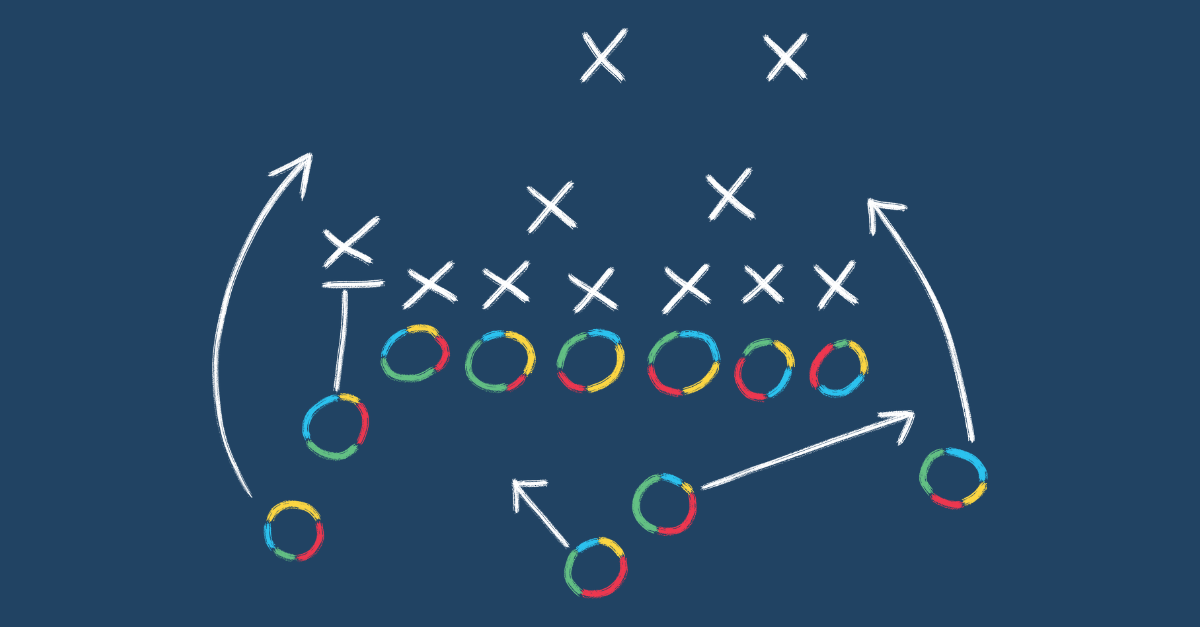Every leader wants a team full of employees who want to get better at their jobs, learn new skills, and further their careers. But how can you meet all of their needs at once? You need a replicable framework that’s consistent in structure but flexible enough for their unique needs. That’s where a professional development plan template can prove invaluable.
U.S. businesses spend more than $100 billion collectively every year on training expenses. And yet too many development efforts lack structure, clarity, and purpose — with neither the employee or the team benefiting. Learn more about some of the most common employee development plans, why professional development plans are important for team growth, how to construct your template, and how Whole Brain® Thinking can help.
What Kinds of Development Plans Are There?
A well-thought-out employee development plan provides your people with the structure and guidance necessary to reach their professional goals while reinforcing your continuous learning and development culture.
There are many kinds of employee development plans, and the right choice for your people depends on what they’re trying to achieve. Pursuing these plans often involves a goal-setting template outlining the starting point, key steps to take, measuring progress, and what success looks like. Here’s an overview of four types of common development plans.
Professional Development
Professional development plans focus on helping employees acquire new skills and knowledge relevant to the workplace. This development is often, but not always, targeted toward the employee’s current organization. These plans are broader than career goals, as they can also help employees looking to change careers or new to the workforce.
These types of plans often take the form of a document that outlines the steps and activities a person needs to take to develop their skills. The plan should be tailored to the person’s goals and updated regularly as conditions change. Such plans might involve the employee undergoing on-the-job or classroom training, receiving mentorship, connecting with an outside coach, taking on temporary projects, or shadowing someone in another job role.
Career Development
Career development plans are tailored to help employees reach career goals by improving specific skills or knowledge areas. These plans usually include short-term and long-term goals intended to help people gain the necessary knowledge, skills, and experience to advance in their careers.
A career development plan might include a self-assessment to help people identify their values, interests, strengths, weaknesses, and experiences to identify their best career options. These findings can be matched against current or anticipated job roles in the organization.
Individual/Personal Development
Individual or personal development plans help people pursue goals that matter to them personally, even if they aren’t directly relevant to their current career path or job. Individual development plans encompass all aspects of a person’s life, including mental and physical health.
Self-improvement is a common theme of these plans, with such goals as developing a more positive mindset, improving physical fitness, or taking on new life challenges. This plan helps people take ownership of their growth in and out of work.
Leadership Development
Leadership development plans are valuable for high-potential employees who must identify and develop the skills needed to become a leader in their organization and field. This plan focuses on teaching employees how to think strategically, communicate effectively with colleagues at all levels, manage difficult conversations, and develop strong teams, among other essential competencies.
This type of development plan contains professional and career development aspects but is targeted toward advancing into the executive ranks.
Sign up to our newsletter for the latest insights
.jpg?width=1200&height=627&name=InternalImageA_ProfessionalDevelopmentPlan%20(1).jpg)
Why Create Professional Development Plans?
Creating professional development plans is essential for any successful team. It provides a road map to ensure employees are making progress toward their professional goals. It allows team leaders to take a proactive approach to skills development rather than waiting for performance problems to arise. It also enables team members to focus on their professional growth instead of relying on their manager to set the direction (or not).
When these plans are developed with managers and human resources (HR), they become collaborative, with everyone taking a stake in the employee’s progression. Professional development plans should be regularly reviewed to ensure they still meet the employee’s needs and reflect their skills and status. In many organizations, these updates can be aligned with manager-employee performance conversations..
Professional development is also a natural fit for teams that use Whole Brain® Thinking. This framework relies on teammates understanding each other’s thinking preferences and embracing those differences for better collective performance. Because the team is always trying to improve their collaboration and performance, they’re always in the development mindset.
How Leaders Can Apply Whole Brain® Thinking to Professional Development
Professional development plans are all about understanding what the employee is thinking, what they want to do with their careers, and what skills they have and don’t have. How they think is just as important as what they’re thinking.
That’s where the Whole Brain® Thinking framework and Herrmann Brain Dominance Instrument (HBDI®) assessment can provide a thoughtful, scientific foundation for professional development. Whole Brain® Thinking decodes how people prefer to think and what types of tasks they prefer to do. The HBDI® assessment helps people understand their thinking preferences across four distinct modes: Analytical (Blue), Structural (Green), Relational (Red), and Experimental (Yellow).
Everyone has a higher thinking preference in one or two quadrants, but we all use all four quadrants daily. There are no good or bad quadrants, nor good or bad combinations of thinking preferences. When people understand how they think, they can use that insight to inform their professional development goals, what skills they need, and how to pursue improvement.
Professional development is a concept and activity that touches upon all four quadrants, providing countless ways for leaders to engage employees. Blue (Analytical) thinkers gravitate toward activities that have clear metrics and outcomes. While professional development plans don’t have to be numbers-based, they should include clear markers of progress and success.
Green (Structural) thinkers tend to think about how activities will be constructed, and the planning process itself could be enough to jump-start their enthusiasm.
Red (Relational) thinkers can envision the impact they can make on their development and the lives of their colleagues, clients, and other stakeholders. By developing a plan, they’re making a personal commitment to their values and impact.
Meanwhile, yellow (Experimental) thinkers will relish the opportunity to dream big and envision the future. They’ll embrace the “why” of professional development planning.
Of course, there are countless Whole Brain® Thinking preferences combinations, and many people will gravitate to more than one quadrant. And even the most Blue thinker possesses a capacity and aptitude for Relational or Experimental thinking, and vice versa. The framework is just that — a way to help your team better understand their thinking and other people’s thinking, not a rigid set of rules about how your team should think or act.
How to Create a Professional Development Plan Template
Templates are a great way to standardize your employee growth efforts while leaving room for each person to set goals and adapt to circumstances. A thoughtful, well-organized template helps employers and employees document goals, track progress, and make refinements whenever needed.
Here are some key components to include in a professional development plan template.
Skills and Knowledge Assessment
Before figuring out where you’re going, you need to know where you are. Make sure to assess current skills and knowledge. That information might already be contained in a performance management system or another HR platform. Professional certifications are another starting point.
Understanding where your people are in terms of skills, competencies, expertise, and interests is essential in identifying what they need to reach their final destination. This assessment should include hard skills, such as technical abilities, and so-called soft skills, such as communication or leadership capabilities.
Goal Setting
Focus on creating specific, measurable, attainable, relevant, and time-bound (SMART) goals. Professional goals aren’t always explicitly tied to a person’s current job, but when conducted within the organization, they should also be aligned with overall objectives. Aim for ambitious yet achievable goals that people will stick with, even after setbacks.
If you’re filling out this template, start by asking what you want to achieve in terms of professional growth. Consider your long-term objectives and what your short- and long-term goals look like to complete that journey.
Blue and Green thinkers will appreciate the template’s clear design and goal-oriented nature. Red thinkers might focus on how this will help them achieve their professional dreams. They’ll also appreciate the checkpoints for recognizing and celebrating progress, especially when they’re team leaders guiding their reports. And Yellow thinkers can dream big, even when they might otherwise feel constrained in their day-to-day, task-based work.
Action Plans
Action plans should detail how each goal will be achieved. These should include specific activities, which must be updated as the employee progresses or as conditions change.
Such activities could include employee training programs, coaching, mentoring, or continuing education. Action steps often get broken down into smaller or subtasks, to make the process more manageable and trackable.
Progress Tracking
Goals require measurement, whether talking about organizational goals, performance management, or professional development. The idea is to spot success, highlight areas of improvement, and give everyone a clear picture of what’s happening and why. The metrics you use in your employee professional development plans will depend on the job role, the goals, and the time frame, among other factors.
Whatever metrics you use, make sure to check progress on a regular cadence, whether that’s automatically generated through an HR software platform or brought up as part of regular check-ins with your employees.
.png?width=1200&height=627&name=InternalImageB_ProfessionalDevelopmentPlan%20(1).png)
An Example of a Professional Development Plan Template
Here’s just one example of a template. The look and feel of your template will depend on many factors, including your team’s structure, the software you use, and the types of goals and metrics you’re using. This example can also serve as a starting point for a career development or individual development plan template.
Professional Development Plan Template
Name: ___________________________________
Department: ________________________________
Self-Assessment (Where You Currently Are):
- ________________________________________________________________
- ________________________________________________________________
- ________________________________________________________________
Objectives or Area of Focus:
- ________________________________________________________________
- ________________________________________________________________
- ________________________________________________________________
Professional Development Needs and Goals:
- ________________________________________________________________
- ________________________________________________________________
- ________________________________________________________________
Current Strengths and Competencies:
- ________________________________________________________________
- ________________________________________________________________
- ________________________________________________________________
Action Steps:
- ________________________________________________________________
- ________________________________________________________________
- ________________________________________________________________
Timeline/Deadline(s):
- ________________________________________________________________
- ________________________________________________________________
- ________________________________________________________________
Support Resources Needed:
- ________________________________________________________________
- ________________________________________________________________
- ________________________________________________________________
How Success Will Be Measured:
- ________________________________________________________________
- ________________________________________________________________
- ________________________________________________________________
Set the Path For Professional Success
Developing an effective professional development plan template is an essential step for any person looking to stay competitive and cutting edge. Not only is professional development a powerful tool for individuals, but it’s also an important way for leaders to develop their teams, improve employee engagement and loyalty, and help their people realize their aspirations.
When you help your team recognize their development opportunities, set achievable goals, and build a timeline filled with measurable action steps, you’ve set your team on the path to sustained success.
Are you looking to improve your interactions with teammates? Learn how to use your HBDI® profile to create a personal user guide.


.png?width=1200&name=Professional%20Development%20Plan-%20Featured%20(1).png)









